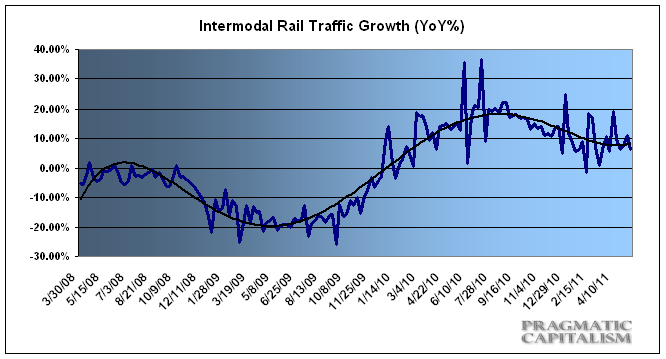Rail traffic has moderated a bit in recent weeks, but it still showing signs of growth. According to the latest from the AAR carloads logged a 1.6% growth rate YoY while intermodal traffic logged a 6.3% rate of growth. More via the AAR:
“The Association of American Railroads (AAR) today reported steady results in weekly rail traffic with U.S. railroads originating 294,271 carloads for the week ending May 14, 2011, up 1.6 percent compared with the same week last year. Intermodal volume for the week totaled 231,875 trailers and containers, up 6.3 percent compared with the same week in 2010.
Ten of the 20 carload commodity groups posted increases from the comparable week in 2010. Commodity groups posting significant increases included: metallic ores, up 17.5 percent; metals and products, up 17.2 percent, and grain, up 14.2 percent. Groups posting a notable decrease included: waste and nonferrous scrap, down 16.9 percent; primary forest products, down 13.6 percent, and farm products excluding grain, down 13 percent.
Weekly carload volume on Eastern railroads was up 1 percent compared with the same week last year. In the West, weekly carload volume was up 2.1 percent compared with the same week in 2010.
For the first 19 weeks of 2011, U.S. railroads reported cumulative volume of 5,527,357 carloads, up 3.3 percent from last year, and 4,234,798 trailers and containers, up 8.8 percent from the same point in 2010.”

Mr. Roche is the Founder and Chief Investment Officer of Discipline Funds.Discipline Funds is a low fee financial advisory firm with a focus on helping people be more disciplined with their finances.
He is also the author of Pragmatic Capitalism: What Every Investor Needs to Understand About Money and Finance, Understanding the Modern Monetary System and Understanding Modern Portfolio Construction.
